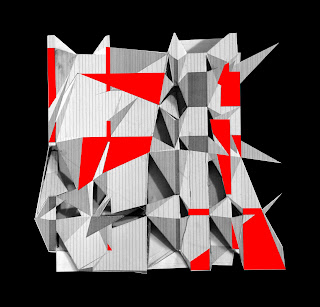Principles from previous model: heights of various components, density of spaces, light and dark conditions
1. The lightest component areas were cut from the pattern (as can be seen from the images of the previous model, these cuts were taken from areas where the sections dispersed and where spaces began to connect and overlap to create open areas)

2. A lower level was created around these cuts to form apertures to a lower level, to create a fully connected and unobstructed space:

2. A lower level was created around these cuts to form apertures to a lower level, to create a fully connected and unobstructed space:
4. The darker components of the pattern were extruded to the maximum height of the previous model, which reflected the large masses that dominated the various sections:
5. Darker components that overlap the lower level were extruded also but only to half the height of the larger masses, to allow for more light into the lower level:
6. The various masses were then connected by creating horizontal planes which overlapped the corresponding components of the pattern below (some of these form the top of the lower level extrusions):
7. The remaining components of the pattern were then represented by more horizontal planes at lower levels. Those components which did not connect masses together became ramps from ground:







No comments:
Post a Comment